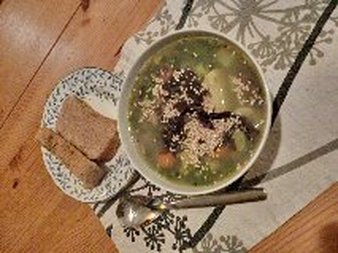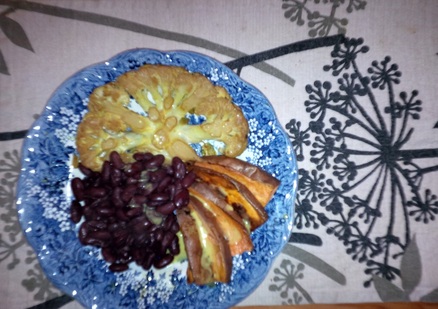
Well, whole doesn't always mean healthful! Nature has exquisite design and whole seeds, beans and legumes have built in defences to make sure they survive. They have evolved to have anti nutrient pesticides (us being the pests) that blocks and protects the seeds innermost nutrients, being the protein and enzymes.
Nuts and seeds are extremely nutrient-dense. They provide generous amounts of calories, fats, complex carbohydrates, protein, vitamins, minerals and fibre. Trace minerals like magnesium, zinc, selenium and copper are important but may be under-consumed in today's largely processed Western diet, and even in some plant-based diets. Nuts and seeds are a reliable and delicious source of these essential nutrients. Plus, more than just a way to meet basic nutrient needs, nuts and seeds have been shown to protect against disease. Phytochemicals, bioactive compounds that help fight illness, in nuts and seeds include ellagic acid, flavonoids, phenolic compounds, luteolin, isoflavones and tocotrienols. Nuts also contain plant sterols, thought to help keep cholesterol levels in check and reduce cancer risk. (1)
We tend to think about brightly colored fruits and vegetables as our best source of phytonutrients, but recent research has recognized black beans as a strong contender in phytonutrient benefits. The seed coat of the black bean (the outermost part that we recognize as the bean's surface) is an outstanding source of three anthocyanin flavonoids: delphinidin, petunidin, and malvidin. These three anthocyanins are primarily responsible for the rich black color that we see on the bean surface. Kaempferol and quercetin are additional flavonoids provided by this legume. Also contained in black beans are hydroxycinnamic acids including ferulic, sinapic, and chlorogenic acid, as well as numerous triterpenoids. Bean species showed variations in anthocyanins and antioxidant activities. Generally, bean species consisting of greater anthocyanins exhibited greater antioxidant activity. Darker varieties consisted of greater antioxidant activity. (2)
Beans and lentils are rich in folic acid, magnesium, potassium, B vitamins, complex carbohydrates and soluble fiber, and, at 20-25% protein by weight, are a go-to for vegetarians and vegans.
Alberta Health Services, The Canadian Diabetes Association, the Canadian Heart and Stroke Association and the Canadian Cancer Society all recommend legumes as one of the most important food groups for disease prevention and optimal health. Due to their blend of fibre, protein and nutrients, legumes aid in blood sugar regulation more than almost any other food group, a key quality for diabetics and those concerned with maintaining stable insulin response. (3,4,5,6)
Legumes are also heart-healthy; their high fibre content lowers cholesterol and triglyceride (blood fat) levels. Most varieties of beans and lentils are also high in folate, a vitamin that helps prevent the build-up of the amino acid homocysteine - elevated levels of which are a major risk factor for heart attack and stroke. (7)
All of these beautiful nutrients are locked in and need a key to open them and make them available to us to absorb.
these plants have evolved defences like phytic acid, enzyme inhibitors, lectins, as their defence arsenal. They are just trying to make it to germination and grow their own.... sound familiar?
Lets look at a few of these defences.
Phytic Acid and Mineral Deficiencies
The most known anti-nutrient found in beans, nuts, grains and seeds is phytic acid (or phytate), a phosphorous-bound organic acid that protects the plant seed from premature germination. When you eat foods with phytic acids still intact, they bind with essential minerals such as calcium, zinc, magnesium, iron and copper and prevent absorption. Phytic acid also has the potential to block protein absorption. (8)
Over time, regularly consuming foods (processed or whole) that contain phytic acid can lead to mineral deficiencies and cause a wide range of health problems including digestive irritability, impaired immune function, allergies, skin irritations, bone lose, decaying teeth, anemia, hormone disruption, and poor physiological development in infants and children.
Phytic acid (IP6) in it'd pure form has been studied and shows anti-tumour anti cancer properties as it is a powerful anti oxidant, (9) but with anything, too much of a good thing can be bad.
Enzyme Inhibitors
Plant seeds, especially nuts and seeds, also contain enzyme inhibitors that ward off predators. These inhibitors block enzyme function, most notably the uptake of trypsin, an enzyme responsible for digesting protein. The increased requirement for pancreatic enzymes also depletes the body of valuable resources for other physiological functions as well, and sets up the conditions for chronic inflammation, insulin resistance, impaired digestion, immune suppression, increased allergies, severe intestinal issues and declined mental function. Any nut butter lovers cringing right now?
Lectins
Although lectins can be found in almost all foods, they are highly concentrated in grains (especially wheat), beans (especially soy), and nuts. They act as very powerful insecticides that ward off predators. When they are consumed in large quantities, such as a diet high in wheat and soy, lectins are a natural disaster for the small intestine. They are carb-binding proteins that can stick to the lining of the small intestine and damage the sensitive villi responsible for transporting nutrients into the bloodstream.
In susceptible people, lectins (among other inflammatory foods and medications) damage the villi so badly that leaky gut syndrome occurs. “Leaky gut” means that the very delicate lining of the small intestine is so damaged that particles of undigested food, proteins, toxins and other pathogens are able “leak” into the bloodstream and bind to tissues and organs throughout the body. As a reaction, the body increases inflammation to protect the affected tissue. This is why lectins can also linked with autoimmune disorders like IBS, Chron’s, colitis, thyroiditis, fibromyalgia, arthritis and so on. (10)
*People that are sensitive or have any kind of inflammatory issues may do well with an elimination diet that includes the elimination of most high lectin foods. The length of time on the elimination diet depends on the severity of the inflammation. Look for a professional holistic nutritionist or ND that is versed in elimination diets focused on you individual needs.
Do what grandma did, and great grandma, and great, great, great....
Our ancestors up until the last mid century may have not had our scientific knowledge of phytonutrients and phytochemicals that act on human digestion but they sure as shootin' knew how to make things from scratch and how to listen to their moms!!!
Grains, beans, nuts and seeds have been soaked and cooked for millenia, They have been part of human diets even before the Indus valley brought rise to agriculture. Wild grassed and pulses date back farther than the agricultural era and we have evolve with these foods long past recorded history.(11,12)
The wisdom of soaking grains, beans and nuts has a long lived tradition, before written words, our human tribe has passed this wisdom on generation to generation. ... until about 50 years ago, the beginning of the convenience era.
Most of the phytic acids, lectins, and enzyme blockers are removed from beans, nuts, legumes, and grains through the soaking and cooking process, except for wheat and soya beans.
Good Soaking Practices
Use a glass or ceramic bowl – Never use plastic or metal.
Purified water – Chemicals and contaminants in tap water can interfere with the soaking process. I use the water from my Reverse Osmosis, re mineralized, filter.
Planning – Knowing you will have to soak requires that you plan your meals ahead of time. It ensures that your meals are planned out ahead of time so you are less likely to opt for something unhealthy.
The three things listed above are all you really need for effective soaking. However, grains, beans, nuts and seeds require a few different tweaks with the soaking process. Temperature, time, and the correct soaking medium can really make a difference.There is a chart at the end of the post.
Raw Nuts and Seeds
Raw nuts and seeds are best soaked in a brine (salt solution) to reduce enzyme inhibitors and increase digestibility. They turn out delicious too!
Soaking medium - 1-2 tsp. of high quality Himalayan Salt. NO TABLE SALT!
Main anti-nutrients deactivated: enzyme inhibitors, lectins
Main Nutrients activated: iron, potassium, magnesium, manganese, selenium, zinc, vitamin E, vitamin C,
These can be dehydrated and stored for longer, better than roasting them to keep their natural oils intact.
Grains
Soaking grains is most optimal with hot water and an acid medium. The acid medium has been shown to release phytase to break down phytic acid. My favorites are raw apple cider or konbucha (because it's always in the fridge)
Soaking medium – lemon juice, raw apple cider vinegar, coconut vinegar, brown rice vinegar, or kombucha
Main anti-nutrients deactivated: phytic acid, lectins
Main Nutrients activated: Vitamin A, E, B6, Lysine, Selenium, Iron, Copper and Zinc
Beans
The optimal method for soaking beans is to start with very hot water and soak at least 24 hours, changing the soak water every 8 hours. I don’t really concern myself with heating the water each time I change it. I think room temperature water is fine to use after the initial rinsing.
Some also claim the acid medium reduces the flavour of the bean and the science does't support clearly whether it helps or not so that's up to you to use it or not.
Since cooking helps to eliminate at least 50% of the phytic acid, I’m okay with just soaking the beans in hot water. For harder, larger beans I’ll throw in a 1/2 tsp. baking soda after the last rinsing. The baking soda literally reduces cooking time by almost half. This is a lifesaver in the kitchen! Do not use baking soda for smaller beans such as lentils, adzuki or navy beans. They’ll cook too fast and become mushy. Make sure you are using a high quality baking soda.
Another option is to add kombu seaweed. This is widely practised in many cultures, because kombu increases the mineral content, especially iodine. This is especially good to use with lentils that you may not soak or cook for as long.
Soaking medium - kombu, or baking soda (for larger beans to reduce cooking time)
Main anti-nutrients deactivated: lectins, oligosaccharides, some phytic acid (cooking eliminates at least half)
Main Nutrients activated: protein, calcium, folate, potassium and iron
Although cooking with dry beans that have been thoroughly soaked is the most ideal and most cost effective, there is always a day where your you just need something quick. Eden Organics provides a wide variety of soaked beans in BPA-free cans. I might suggest keeping a can or two in the pantry for last minute meals.
Use your soaked beans, legumes, nuts and seeds within a few days of soaking as to not develop mold spores. You can dehydrate all of the above ( mostly nuts and seeds) for the benefits of this process without having to roast them. This may degrade their delicate oils.
Also be aware of how much processed grains you are eating, if there un-soaked, or un-sprouted, they're not most nourishing. That's where the beautiful food diary comes in handy.
For a Chart on soaking refer to the reference page.
So Soak, sprout, and let your tummy smile!
References;
1)PubMed; Health Benefits of Nut Consumption PMCID: PMC3257681
http://www.ncbi.nlm.nih.gov/pmc/articles/PMC3257681/
2) African Journal of Agricultural Research; Anthocyanin content and antioxidant activities of common bean species (Phaseolus vulgaris L.) grown in Mashonaland Central, Zimbabwe Dzomba P.*, Togarepi E. and Mupa M.
http://www.academicjournals.org/article/article1380887529_Dzomba%20et%20al.pdf
3) Alberta Health Services; Fibre Facts
http://www.albertahealthservices.ca/hp/if-hp-tr-en-fibre-facts.pdf
4) Canadian Diabetes Association; Fibre
http://www.diabetes.ca/diabetes-and-you/healthy-living-resources/diet-nutrition/fibre
5)Heart and Stroke Association;Fibre
http://www.heartandstroke.com/site/c.ikIQLcMWJtE/b.3484239/k.6942/Healthy_living__Fibre.htm
6)Canadian Cancer Society; Fibre
http://www.cancer.ca/en/cancer-information/cancer-101/what-is-a-risk-factor/diet/fibre/?region=on
7)Oregon State University;Linus Pauling Institute; Folate
http://lpi.oregonstate.edu/infocenter/vitamins/fa/
8) Wiki; Phytic Acid
http://en.wikipedia.org/wiki/Phytic_acid
9) PubMed;PMC3474917; The effect of inositol hexaphosphate on the expression of selected metalloproteinases and their tissue inhibitors in IL-1β-stimulated colon cancer cells
http://www.ncbi.nlm.nih.gov/pmc/articles/PMC3474917/
10)PubMed; The Dietary Intake of Wheat and other Cereal Grains and Their Role in Inflammation
http://www.ncbi.nlm.nih.gov/pmc/articles/PMC3705319/
11) DW;Paleolithic humans refined grains in addition to eating meat
http://www.dw.de/paleolithic-humans-refined-grains-in-addition-to-eating-meat/a-6126777
12) Research Gate; Mousterian vegetal food in Kebara Cave, Mt. Carmel
http://www.researchgate.net/publication/222658340_Mousterian_vegetal_food_in_Kebara_Cave_Mt._Carmel
